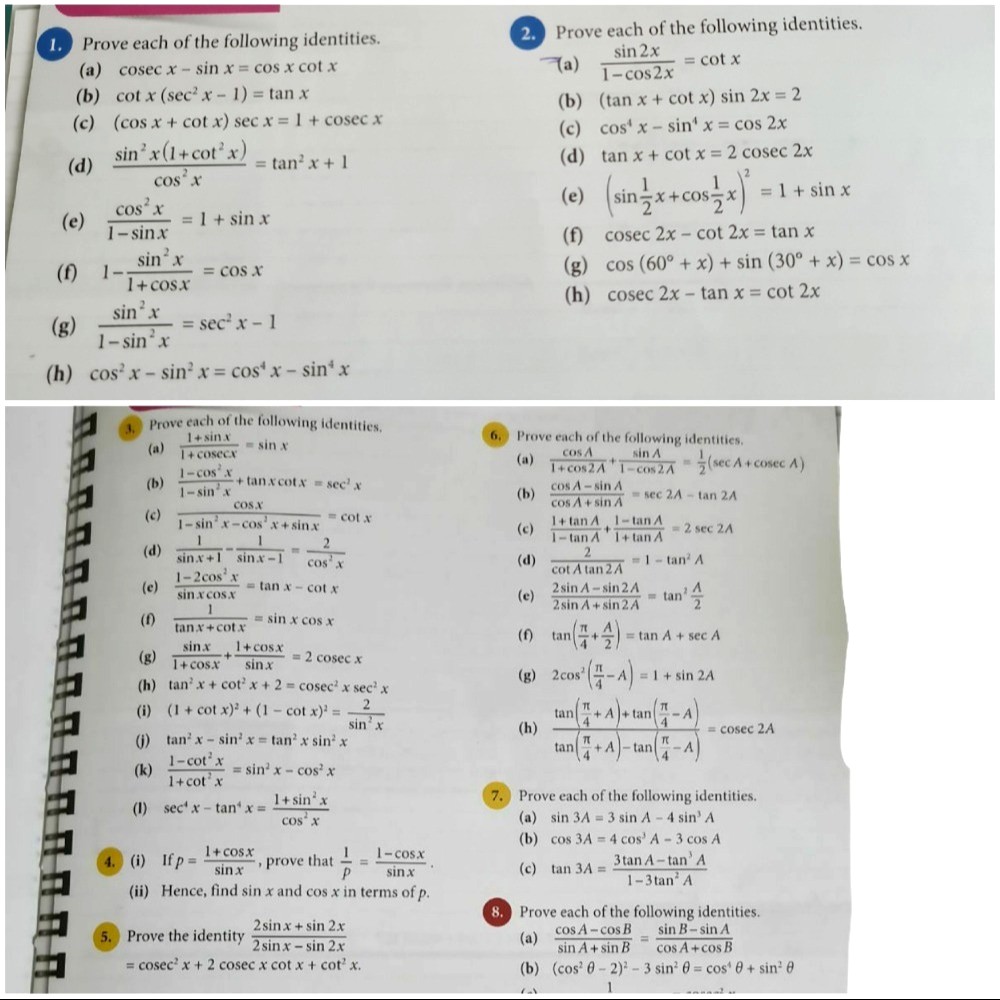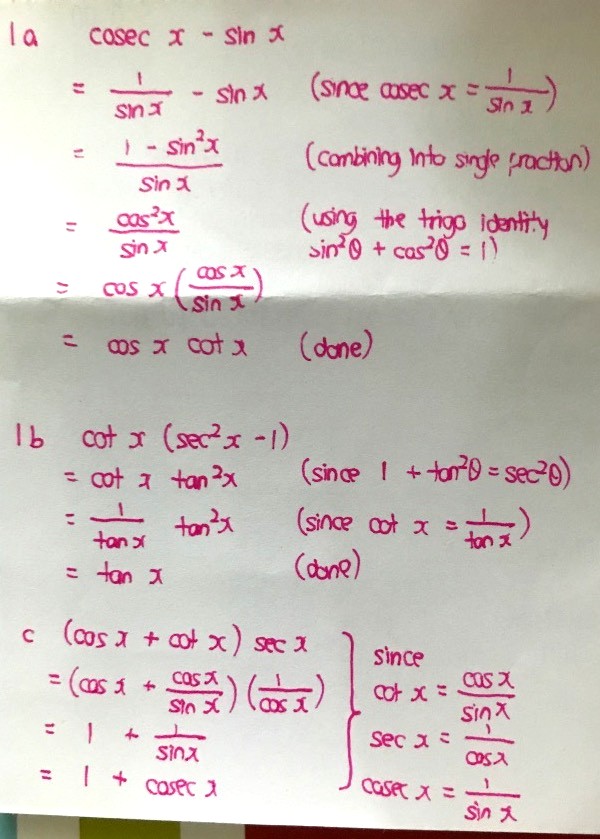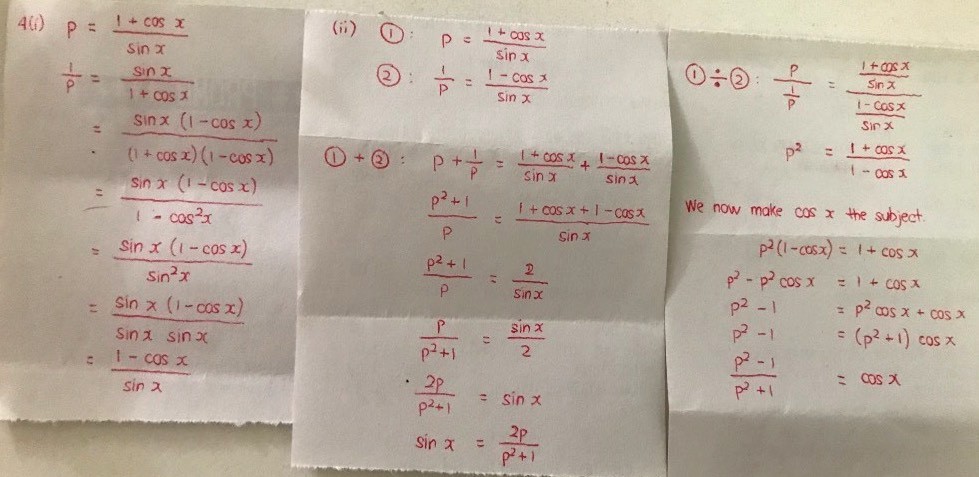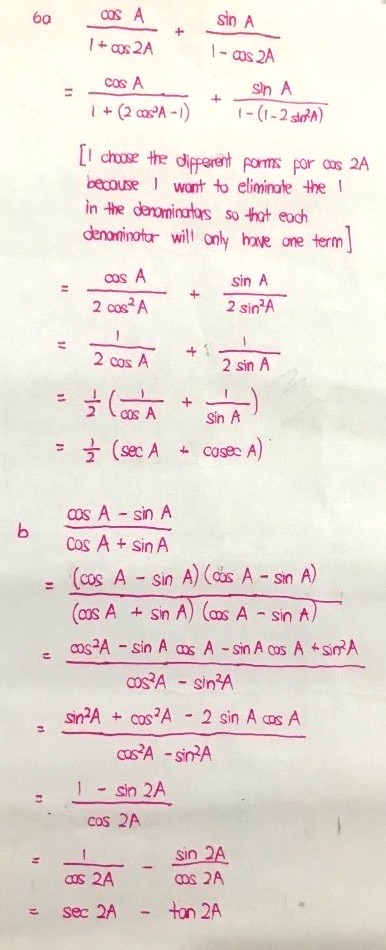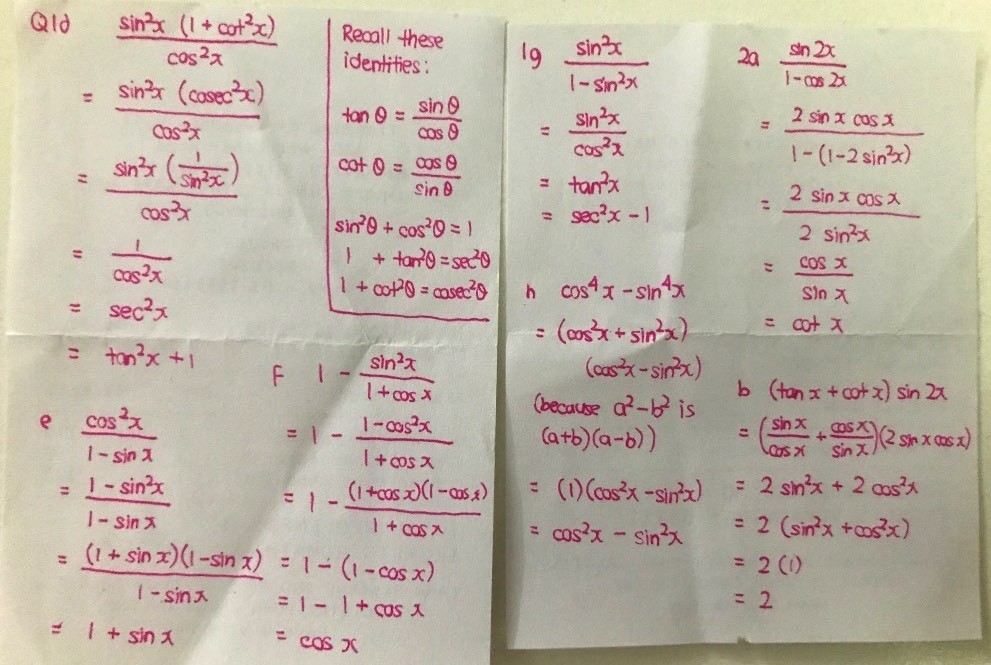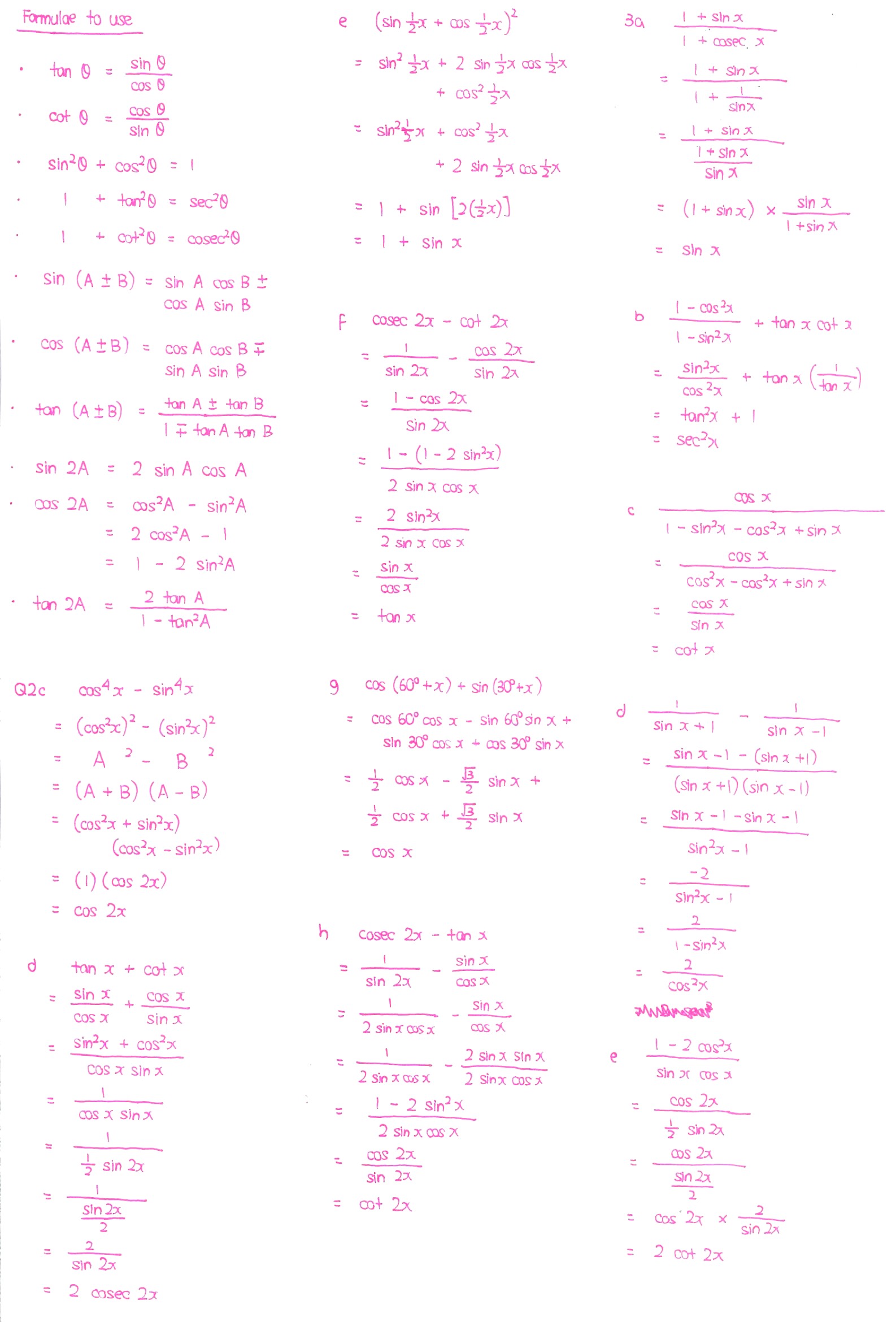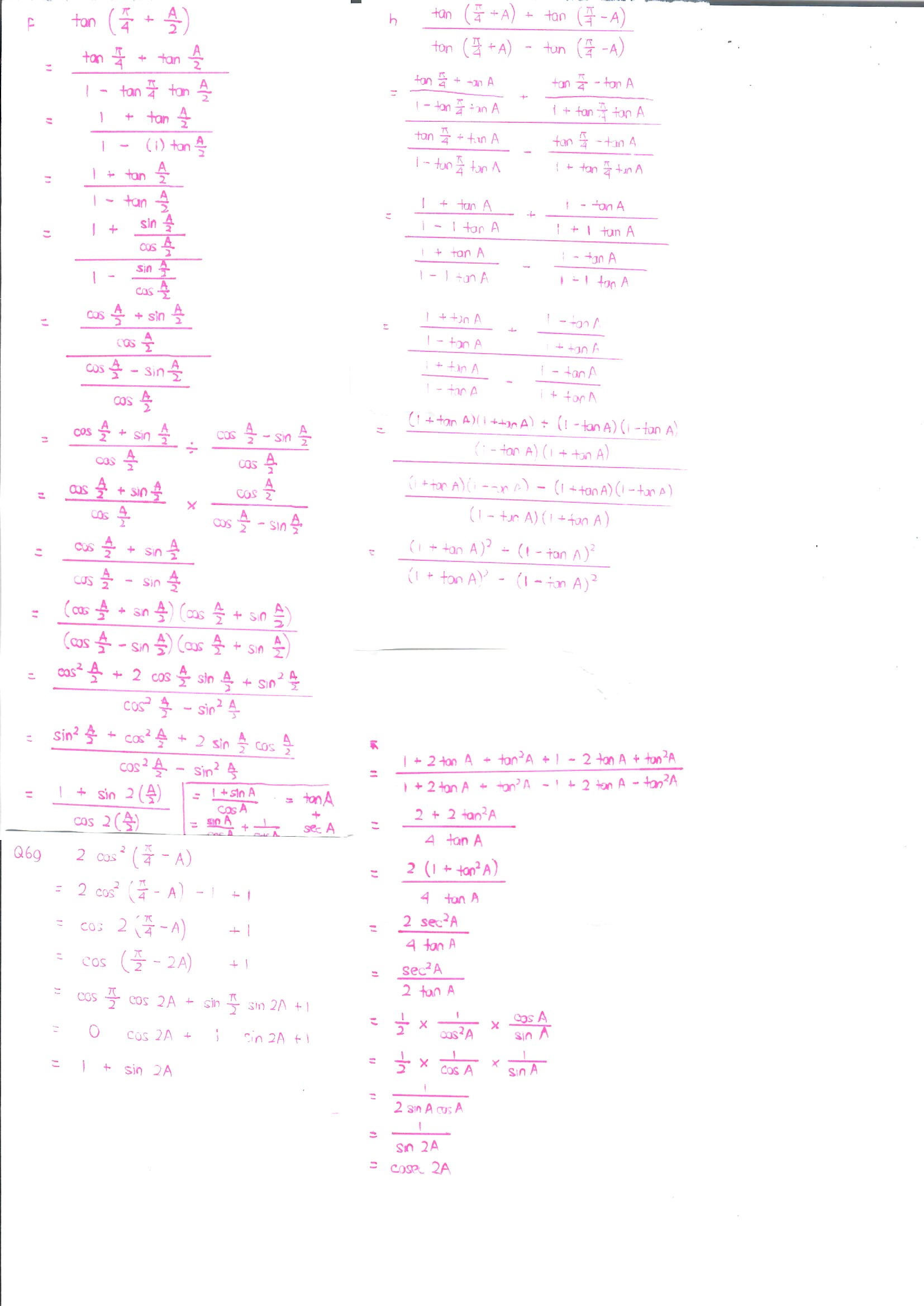Ask Singapore Homework?
Upload a photo of a Singapore homework and someone will email you the solution for free.

See 7 Answers
done
{{ upvoteCount }} Upvotes
clear
{{ downvoteCount * -1 }} Downvotes
Q1a, Q1b, Q1c
In this section of trigo, we are supposed to prove the equality of the given statement using a series of techniques, some of which are
- combining into single fraction
- breaking of fractions
- breaking down all trigo ratios into sines and cosines only
- usage of the most basic standard trigonometric identities
- introducing conjugates (as we do for surds)
- introducing common multipliers in the numerator and denominator
- observation of signages at the start and at the end (sometimes the minus sign vanishes at the end of the proof, so these tells us something)
- and many more
A combination of these techniques are usually used.
I will only do these three now; the rest only if I can remember another time and I am more free or I am not that lazy or tired
In this section of trigo, we are supposed to prove the equality of the given statement using a series of techniques, some of which are
- combining into single fraction
- breaking of fractions
- breaking down all trigo ratios into sines and cosines only
- usage of the most basic standard trigonometric identities
- introducing conjugates (as we do for surds)
- introducing common multipliers in the numerator and denominator
- observation of signages at the start and at the end (sometimes the minus sign vanishes at the end of the proof, so these tells us something)
- and many more
A combination of these techniques are usually used.
I will only do these three now; the rest only if I can remember another time and I am more free or I am not that lazy or tired
Date Posted:
3 years ago
how to know which side to start with tho
i dont really understand part c
For part c, we have to re-express our trigonometric functions in terms of sines and cosines only. After which, we do rainbow expansion like regular algebraic expressions.
We typically start out proving from the LHS but usually we analyse the equation first before starting off from the more complicated side first.
We typically start out proving from the LHS but usually we analyse the equation first before starting off from the more complicated side first.
I am currently overloaded with work once again and I have yet to call for a rest day so I am unlikely to look at your remaining questions for several days in a row
ok.. will you be free anytime soon?
I still have four students’ work of workload to do at the moment which I will only be able to clear in two days. After which, I might take a day of break because I have not had a single full day of break for quite some time.
I might look at your questions slowly from three days later.
I might look at your questions slowly from three days later.
I look at some questions later. I have cleared all of my work so far.
ok tyvm! :)
I will reach home at 3 am today, then do one or two questions
done
{{ upvoteCount }} Upvotes
clear
{{ downvoteCount * -1 }} Downvotes
Q4 requires rigorous understanding of how sines and cosines work and how we manipulate equations to obtain sin x and cos x as subjects. The simuls involved are complicated.
Q6 I do another time
Q6 I do another time
Date Posted:
3 years ago
dont really understand this qn...
The difficulty in this question lies in understanding how equations work. I can't explain all here, but the basic idea is for us to actually find a way to eliminate unknowns.
Part i is easy, as this requires us to simply transform an equation to a second.
Part ii is tougher, as you need to obtain sin x and cos x individually in terms of p only. To do this, we must somehow get rid of the sin x (if we wish to keep the cos x) or get rid of the cos x (if we wish to keep the sin x).
This is done by elimination of unknowns. Getting the sin x is easier, because we can simply add both p and 1/p together to eliminate the cos x. The sin x one is much harder to eliminate and requires you to know your "make the subject of the formula" concept inside out.
Part i is easy, as this requires us to simply transform an equation to a second.
Part ii is tougher, as you need to obtain sin x and cos x individually in terms of p only. To do this, we must somehow get rid of the sin x (if we wish to keep the cos x) or get rid of the cos x (if we wish to keep the sin x).
This is done by elimination of unknowns. Getting the sin x is easier, because we can simply add both p and 1/p together to eliminate the cos x. The sin x one is much harder to eliminate and requires you to know your "make the subject of the formula" concept inside out.
done
{{ upvoteCount }} Upvotes
clear
{{ downvoteCount * -1 }} Downvotes
Q6a, Q6b
The rest another time
The rest another time
Date Posted:
3 years ago
If I have time later at night, I do a few of them
ok thx :)
by the way i might have to mark this question as done first as i need to post some other emath questions here
by the way i might have to mark this question as done first as i need to post some other emath questions here
by the way are you able to help today?
Currently on my list of questions I have zero questions, so I might be looking at your questions tonight unless I forget, become tired or suddenly receive questions from my students
ok sure
how to know when to introduce conjugates? quite complicated...
Usually I introduce conjugates when a denominator contains two terms. In many cases, this leads to us being able to simplify the denominator into a single term rather than the sum of two terms.
This technique is important as divisions by the sum of two terms in the denominator is much more difficult than divisions by a single term denominator,
This technique is important as divisions by the sum of two terms in the denominator is much more difficult than divisions by a single term denominator,
done
{{ upvoteCount }} Upvotes
clear
{{ downvoteCount * -1 }} Downvotes
Q1d to Q2b
In this proving chapter, you need to know all your trigonometric identities inside out. For question 2, there are new formulae to consider as well, coming from the addition and double angle formulae.
In this proving chapter, you need to know all your trigonometric identities inside out. For question 2, there are new formulae to consider as well, coming from the addition and double angle formulae.
Date Posted:
3 years ago
i dont really understand 2a at the part 2sinxcosx/2sin^2x become cosx/sinx
i dont understand 2b as i dont really know how does multiplication and division works for trigo...
i dont really understand 2a at the part 2sinxcosx/2sin^2x become cosx/sinx
For this one, it's just cancellation of common terms on top and below. Note that sin^2 x means sin x times sin x (the angles do not multiply), so that the 2 cancels the 2 and the sin x on top cancels one of the sin x below.
-----------------------------------------------
i dont understand 2b as i dont really know how does multiplication and division works for trigo...
They work the same way as regular multiplication and division, except that angles do not get multiplied or divided.
For this one, it's just cancellation of common terms on top and below. Note that sin^2 x means sin x times sin x (the angles do not multiply), so that the 2 cancels the 2 and the sin x on top cancels one of the sin x below.
-----------------------------------------------
i dont understand 2b as i dont really know how does multiplication and division works for trigo...
They work the same way as regular multiplication and division, except that angles do not get multiplied or divided.
These type of trigonometric proving questionsusually carry high marks, but most questions are easily doable if you follow the techniques which I have listed out. Question 2a usually carries 2 marks in a school exam and 3 marks in an O Level exam.
i have attempted qn 6 and 4 but i cant do any of it tho.. can you help me with it? for the other questions, i will check if i can do later after looking at these examples
done
{{ upvoteCount }} Upvotes
clear
{{ downvoteCount * -1 }} Downvotes
Q2c to Q3d
The rest another time.
The rest another time.
Date Posted:
3 years ago
i dont understand 2e
2e is pretty straightforward as we simply expand the term in the brackets as per the usual (a + b)² expansion.
Note that sin²A + cos²A equals 1, regardless of the choice of the angle A. This applies to sin²(0.5x) + cos²(0.5x) as it happens in the question.
The other term in the expansion, 2 sin 0.5x cos 0.5x takes on the form 2 sin A cos A which becomes sin 2A, so 2 sin 0.5x cos 0.5x becomes sin x.
Note that sin²A + cos²A equals 1, regardless of the choice of the angle A. This applies to sin²(0.5x) + cos²(0.5x) as it happens in the question.
The other term in the expansion, 2 sin 0.5x cos 0.5x takes on the form 2 sin A cos A which becomes sin 2A, so 2 sin 0.5x cos 0.5x becomes sin x.
done
{{ upvoteCount }} Upvotes
clear
{{ downvoteCount * -1 }} Downvotes
Q6c, Q6d, Q6e
Date Posted:
3 years ago
i dont really understand the change from 2nd to 3rd column at part e
For the second column to the third column, I simply factorised out common terms in the numerator and common terms in the denominator, which is very common in E Maths, but it's harder to identify them here because sine is also involved.
ok thx :) btw are you able to help with some qns today? i have post some qns that i urgently need help with
done
{{ upvoteCount }} Upvotes
clear
{{ downvoteCount * -1 }} Downvotes
Q6f, Q6g, Q6h
Date Posted:
3 years ago
thx :) btw are you able to help with some qns now?
You can post some questions first and if later I have time, I do
done
dont really understand part g..
Part g is not easy unless you recognise that 2 cos²A appears in the formula
cos 2A = 2 cos²A - 1
which in turn can be arranged to become
2 cos²A = cos 2A + 1
Here, it's not exactly 2 cos²A, but it's 2 cos²(pi/4 - A).
By letting u = pi/4 - A, we can simplify the above into a more recognisable expression.
2 cos² (pi/4 - A)
= 2 cos² u
= cos 2u + 1
But u = pi/4 - A, so 2u = pi/2 - 2A and the above continues, with the help of the addition formula, as
...
= cos (pi/2 - 2A) + 1
= cos pi/2 cos 2A + sin pi/2 sin 2A + 1
= 0 cos 2A + 1 sin 2A + 1
= sin 2A + 1
cos 2A = 2 cos²A - 1
which in turn can be arranged to become
2 cos²A = cos 2A + 1
Here, it's not exactly 2 cos²A, but it's 2 cos²(pi/4 - A).
By letting u = pi/4 - A, we can simplify the above into a more recognisable expression.
2 cos² (pi/4 - A)
= 2 cos² u
= cos 2u + 1
But u = pi/4 - A, so 2u = pi/2 - 2A and the above continues, with the help of the addition formula, as
...
= cos (pi/2 - 2A) + 1
= cos pi/2 cos 2A + sin pi/2 sin 2A + 1
= 0 cos 2A + 1 sin 2A + 1
= sin 2A + 1

